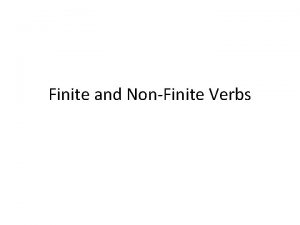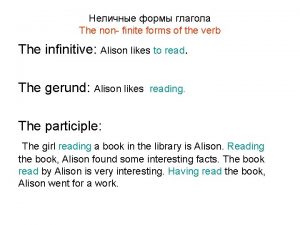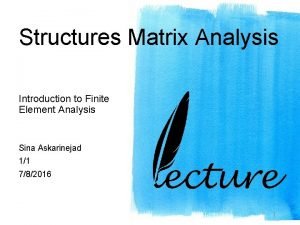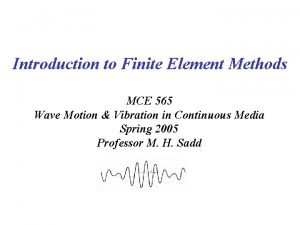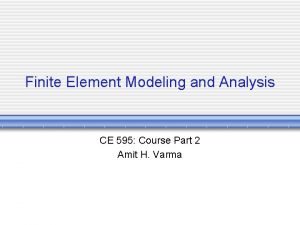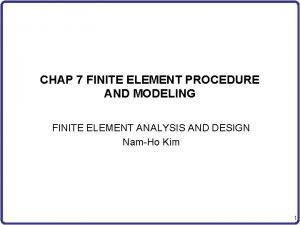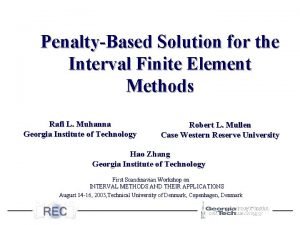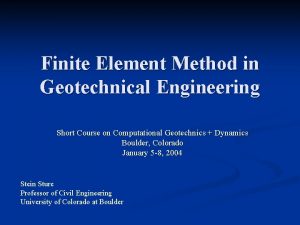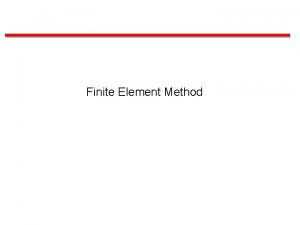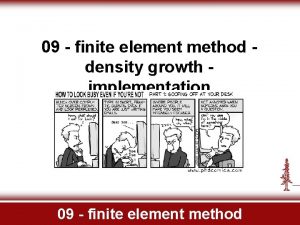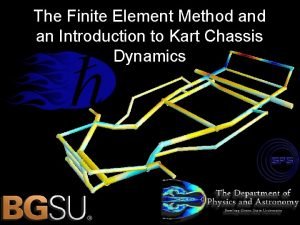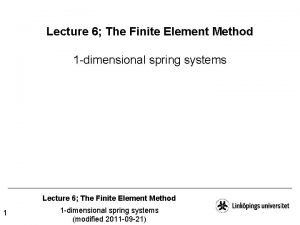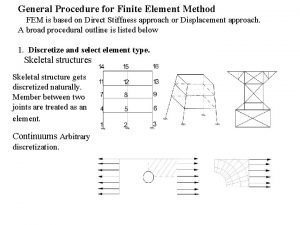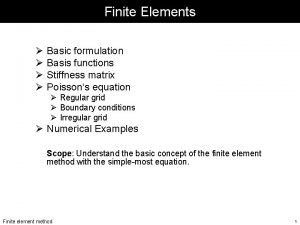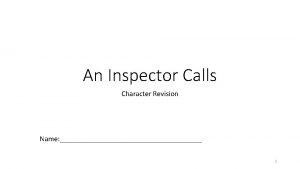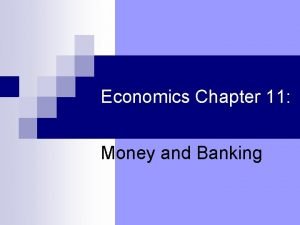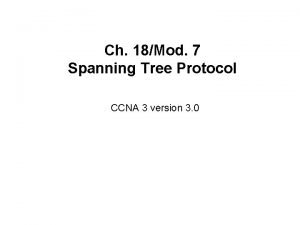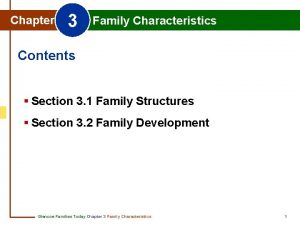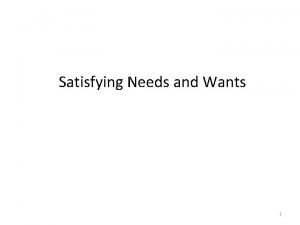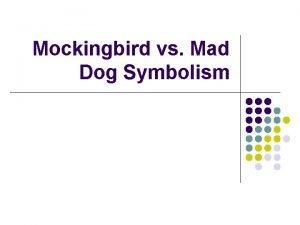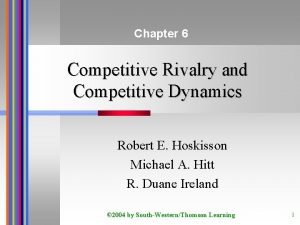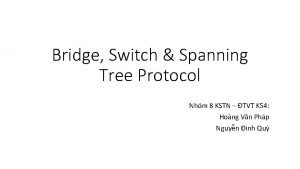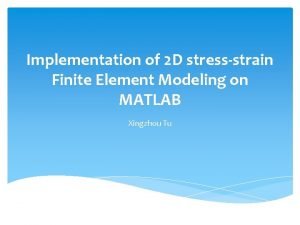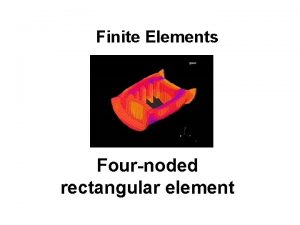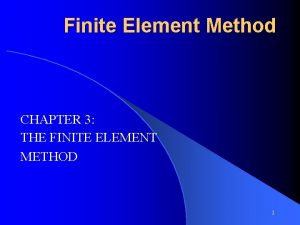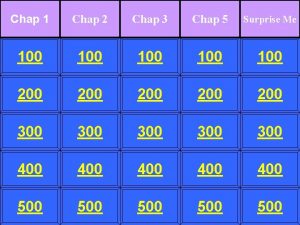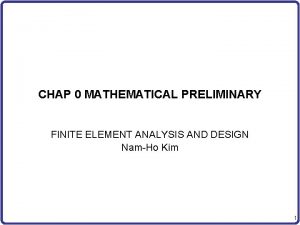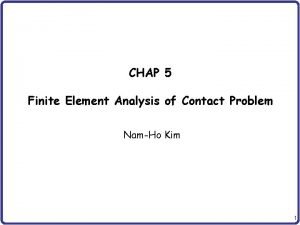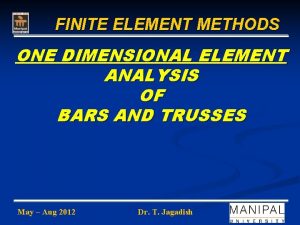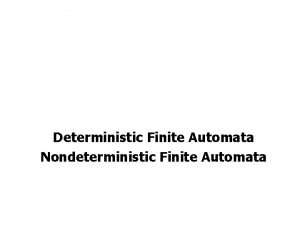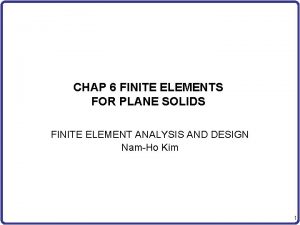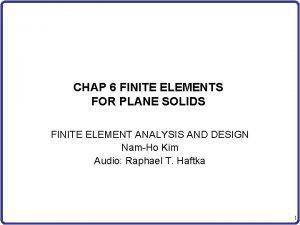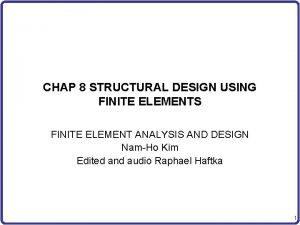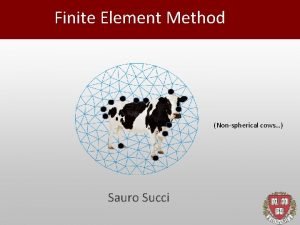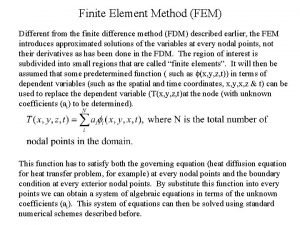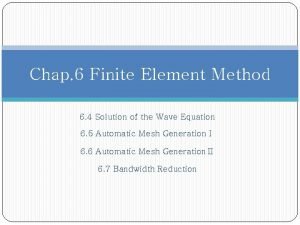CHAP 1 STRESSSTRAIN ANALYSIS FINITE ELEMENT ANALYSIS AND








![STRESS TRANSFORMATION cont. • All three-directions • Matrix notation – [ ]: stress matrix; STRESS TRANSFORMATION cont. • All three-directions • Matrix notation – [ ]: stress matrix;](https://slidetodoc.com/presentation_image_h2/5225c979fda00f84686e468754fd6600/image-9.jpg)






![COORDINATE TRANSFORMATION – When [σ]xyz is given, what would be the components in a COORDINATE TRANSFORMATION – When [σ]xyz is given, what would be the components in a](https://slidetodoc.com/presentation_image_h2/5225c979fda00f84686e468754fd6600/image-16.jpg)
![COORDINATE TRANSFORMATION cont. – [N] transforms a vector in the x′y′z′ coordinates into the COORDINATE TRANSFORMATION cont. – [N] transforms a vector in the x′y′z′ coordinates into the](https://slidetodoc.com/presentation_image_h2/5225c979fda00f84686e468754fd6600/image-17.jpg)








![STRESS VS STRAIN [ ] is a symmetric 3× 3 matrix Normal stress in STRESS VS STRAIN [ ] is a symmetric 3× 3 matrix Normal stress in](https://slidetodoc.com/presentation_image_h2/5225c979fda00f84686e468754fd6600/image-26.jpg)


















- Slides: 44

CHAP 1 STRESS-STRAIN ANALYSIS FINITE ELEMENT ANALYSIS AND DESIGN Nam-Ho Kim 1

STRESS • Stress – Fundamental concept related to the safety of a structure – Often used as criteria for mechanical design – Internal force created by deforming the shape against external loads. – Linear elasticity: the relation between internal force and deformation is linear. 2

SURFACE TRACTION • Surface traction (Stress) – The entire body is in equilibrium with external forces (f 1 ~ f 6) – The imaginary cut body is in equilibrium due to external forces (f 1, f 2, f 3) and internal forces – Internal force acting at a point P on a plane whose unit normal is n: – The surface traction depends on the unit normal direction n. – Surface traction will change when n changes. – unit = force per unit area (pressure) 3

NORMAL AND SHEAR STRESSES • Normal and shear stresses – Decompose T(n) into normal and tangential components n normal stress component parallel to n n shear stress component perpendicular to n What if T(n) and n are in the same direction? • Practice Example 1. 2 in the textbook 4

CARTESIAN STRESS COMPONENTS – – – Surface traction changes according to the direction of the surface. Impossible to store stress information for all directions. Let’s store surface traction parallel to the three coordinate directions. Surface traction in other directions can be calculated from them. Consider the x-face of an infinitesimal cube x z z txz F txy sxx x y y 5

CARTESIAN COMPONENTS cont. – – – First index is the face and the second index is its direction When two indices are the same, normal stress, otherwise shear stress. Continuation for other surfaces. Total nine components Same stress components are defined for the negative planes. Comp. Description xx Normal stress on the x face in the x dir. yy Normal stress on the y face in the y dir. zz Normal stress on the z face in the z dir. xy Shear stress on the x face in the y dir. yx Shear stress on the y face in the x dir. yz Shear stress on the y face in the z dir. zy Shear stress on the z face in the y dir. xz Shear stress on the x face in the z dir. zx Shear stress on the z face in the x dir. 6

CARTESIAN COMPONENTS cont. • Sign convention – Positive when tension and negative when compression. – Shear stress acting on the positive face is positive when it is acting in the positive coordinate direction. • Example 7

STRESS TRANSFORMATION – If stress components in xyz-planes are known, it is possible to determine the surface traction acting on any plane. – Consider a plane whose normal is n. – Surface area ( ABC = A) – The surface traction – Force balance (h → 0) 8
![STRESS TRANSFORMATION cont All threedirections Matrix notation stress matrix STRESS TRANSFORMATION cont. • All three-directions • Matrix notation – [ ]: stress matrix;](https://slidetodoc.com/presentation_image_h2/5225c979fda00f84686e468754fd6600/image-9.jpg)
STRESS TRANSFORMATION cont. • All three-directions • Matrix notation – [ ]: stress matrix; completely characterize the state of stress at a point • Normal and shear components 9

SYMMETRY OF STRESS TENSOR – Stress tensor should be symmetric 9 components 6 components – Equilibrium of the angular moment – Similarly for all three directions: – Let’s use vector notation: 10

PRINCIPAL STRESSES – – – Can it be possible to find planes that have zero shear stresses? Normal stress = principal stress Normal direction = principal direction Extreme values (max or min) of stress at the point Three principal stresses and directions. Stress vector (T(n)) // normal vector (n) n and n are unknown n : principal stress n: principal direction Eigenvalue problem What would be the solution? 11

PRINCIPAL STRESSES cont. – n = 0 satisfies the equation: trivial solution – Non-trivial solution when the determinant is zero. – Expanding the determinant equation: – I 1, I 2, I 3: invariants of the stress matrix [σ], which are independent of coordinate systems. – Three roots: principal stresses, 12

PRINCIPAL DIRECTION – Calculate principal direction using principal stress. – Substitute each principal stress at a time. – Since the determinant is zero (i. e. , the matrix is singular), three equations are not independent. – An infinite number of solutions exist. – Need one more relation to uniquely determine n. – Infinite solutions mean the same direction with different magnitude. We select the one that has unit magnitude 13

PRINCIPAL DIRECTION cont. – Planes on which the principal stresses act are mutually perpendicular – Let’s consider two principal directions ni and nj, with i ≠ j. – Scalar products using nj and ni, – Subtract two equations, – Since two principal stresses are different, 14

PRINCIPAL DIRECTION cont. • There are three cases for principal directions: 1. σ1, σ2, and σ3 are distinct principal directions are three unique mutually orthogonal unit vectors. 2. σ1 = σ2 and σ3 are distinct n 3 is a unique principal direction, and any two orthogonal directions on the plane that is perpendicular to n 3 are principal directions. 3. σ1 = σ2 = σ3 any three orthogonal directions are principal directions. This state of stress corresponds to a hydrostatic pressure. n 3 15
![COORDINATE TRANSFORMATION When σxyz is given what would be the components in a COORDINATE TRANSFORMATION – When [σ]xyz is given, what would be the components in a](https://slidetodoc.com/presentation_image_h2/5225c979fda00f84686e468754fd6600/image-16.jpg)
COORDINATE TRANSFORMATION – When [σ]xyz is given, what would be the components in a different coordinate system x′y′z′ (i. e. , [σ]x′y′z′)? – Unit vectors in x′y′z′-coordinates: – b 1 = {1, 0, 0}T in x′y′z′ coordinates, while in xyz coordinates – the rotational transformation matrix – Stress does not rotate. The coordinates rotate 16
![COORDINATE TRANSFORMATION cont N transforms a vector in the xyz coordinates into the COORDINATE TRANSFORMATION cont. – [N] transforms a vector in the x′y′z′ coordinates into the](https://slidetodoc.com/presentation_image_h2/5225c979fda00f84686e468754fd6600/image-17.jpg)
COORDINATE TRANSFORMATION cont. – [N] transforms a vector in the x′y′z′ coordinates into the xyz coordinates, while [N]T transforms a vector in the xyz coordinates into the x′y′z′ coordinates. – Consider bx′y′z′ = {1, 0, 0}T: – Stress transformation: Using stress vectors, – By multiplying [N]T the stress vectors can be represented in the x′y′z′ coordinates – The first [N] transforms the plane, while the second transforms the force. 17

MAXIMUM SHEAR STRESS – Important in the failure criteria of the material – Mohr’s circle – maximum shear stress – Normal stress at max shear stress plane 18

What Stress Could Be Design Criteria? – It must be independent of the coordinate system. – Stress Invariants – Principal Stresses – Maximum Shear Stress 19

Homework #2 2. Direction nx: ny: nz = 3: 4: 12. Determine T(n), magnitude of T(n), normal stress n, shear stress n, angle between T(n) and n. 4. If xx = 90, yy = − 45, xy = 30, and zz = xz = yz = 0, find T(n), n, and n. yy xy n xy xx xy 40 o xy xx yy 20

Homework #2 7. Determine the principal stresses and their associated directions, when the stress matrix at a point is given by 8. Let x′y′z′ coordinate system be defined using the three principal directions obtained from Problem 7. Determine the transformed stress matrix [σ]x′y′z′ in the new coordinates system 21

STRAIN • Strain: a quantitative measure of deformation – Normal strain: change in length of a line segment – Shear strain: change in angle between two perpendicular line segments • Displacement of P = (u, v, w) • Displacement of Q & R R' Q' R P'(x+u, y+v, z+w) y y x P(x, y, z) Q x z 22

STRAIN – Strain is defined as the elongation per unit length uy y P x ux P – Tensile (normal) strains in x- and y-directions Textbook has different, but more rigorous derivations – Strain is a dimensionless quantity. Positive for elongation and negative for compression 23

SHEAR STRAIN – Shear strain is the tangent of the change in angle between two originally perpendicular axes ux q 2 y P – Shear strain (change of angle) p/2 – g 12 x q 1 uy – Positive when the angle between two positive (or two negative) faces is reduced and negative when the angle is increased. – Valid for small deformation 24

STRAIN MATRIX – Strain matrix and strain vector – Normal component: – – Coordinate transformation: Principal strain: ε 1 ≥ ε 2 ≥ ε 3 Maximum shear strain: • Will the principal direction of strain be the same as that of stress? 25
![STRESS VS STRAIN is a symmetric 3 3 matrix Normal stress in STRESS VS STRAIN [ ] is a symmetric 3× 3 matrix Normal stress in](https://slidetodoc.com/presentation_image_h2/5225c979fda00f84686e468754fd6600/image-26.jpg)
STRESS VS STRAIN [ ] is a symmetric 3× 3 matrix Normal stress in the direction n is Normal strain in the direction n is Transformation of stress Transformation of strain Three mutually perpendicular principal directions and principal stresses can be computed as eigenvalues and eigenvectors of the stress matrix as Three mutually perpendicular principal directions and principal strains can be computed as eigenvalues and eigenvectors of the strain matrix as 26

STRESS-STRAIN RELATIONSHIP • • Applied Load shape change (strain) stress There must be a relation between stress and strain Linear Elasticity: Simplest and most commonly used Uni-axial Stress: – Axial force F will generate stress – In the elastic range, the relation between stress and strain is – Reduction of cross-section – E: Young’s modulus, : Poisson’s ratio 27

UNI-AXIAL TENSION TEST Terms Explanations Proportional limit The greatest stress for which stress is still proportional to strain Elastic limit The greatest stress without resulting in any permanent strain Yield stress The stress required to produce 0. 2% plastic strain Strain hardening A region where more stress is required to deform the material Ultimate stress The maximum stress the material can resist Necking Cross section of the specimen reduces during deformation Fracture Material failure 28

LINEAR ELASTICITY (HOOKE’S LAW) • When the material is in the Proportional Limit (or Elastic Limit) • In General 3 -D Relationship Stress-Strain Matrix – For homogeneous, isotropic material 36 constants can be reduced to 2 independent constants. 29

LINEAR ELASTICITY (HOOKE’S LAW) cont. • Isotropic Material: – Stress in terms of strain: – Strain in terms of stress Shear Modulus 30

DEGENERATION TO 2 D • Plane Strain Problem – 3 D engineering problems are often simplified to 2 D problems – Deformation in z-dir is constrained – Strains in z-dir are zero y y x Normal stress in z-dir x z 31

DEGENERATION TO 2 D cont. • Plane Stress Problem: – Plate-like structure under in-plane loads – No constraints in thickness dir – Stresses in z-dir are zero – Stress-strain relation 32

EQUILIBRIUM EQUATIONS • Equilibrium Relation (2 D) • Equilibrium Relation (3 D) 33

BOUNDARY-VALUE PROBLEM • When boundary conditions are given, how can we calculate the displacement, stress, and strain of the structure? – Solve for displacement – – – Equilibrium equation Constitutive equation (Stress-strain relation) Strain definition Load and boundary conditions Compatibility conditions 34

FAILURE THEORIES • Materials fail because the stress exceed the strength → Need to specify the exact stress type to determine failure → Design Criteria • Material failure → Ductile materials (metals): yield stress → Brittle materials (ceramics): ultimate stress, fracture • Materials don’t fail by changing volume (inter-atomic distance) • Shear stress (distortion of shape) is related to material failure. • Two Categories: stress-based and energy-based 35

STRAIN ENERGY • Force Deformation Stress Stored Energy • Strain Energy Density: • 3 -D situation: • Use principal stress-strain relation • Strain Energy Density: in terms of principal stresses 36

DECOMPOSITION OF ENERGY • Hydrostatic Stress (Volumetric stress) – Hydrostatic pressure does not contribute to failure – Thus, subtract the volumetric strain energy from total strain energy. – Hydrostatic pressure: same for all directions – Strain energy density caused by h: 37

DECOMPOSITION OF ENERGY cont. • Distortion Energy Density Von Mises Stress This energy contributes to material failure 38

DISTORTION ENERGY THEORY • Von Mises (1913) – Material fails when the distortion energy reaches a certain level. – Material yields in the tensile test when xx = Y, and all others are zero – Distortion energy when the material yields in tensile test – In general stress status, the material yields when the distortion energy is greater than that of the tensile test at yielding: – Without calculating distortion energy, just compare the von Mises stress with yield stress of the tensile test: 39

DISTORTION ENERGY THEORY cont. – 3 D stress status – 2 D (when 3 = 0) 40

DISTORTION ENERGY THEORY cont. • Example: Pure Shear Problem – 1 = = – 3 and 2 = 0 – straight line through the origin at – 45º 1 3 - s 3 A Safe region s 1 B Material failure 41

MAX SHEAR STRESS THEORY • Tresca (1864) – Material fails when the max. shear stress exceeds the shear stress in a tensile specimen at yield. 1 – In tensile test, 1 = Y, 2 = 3 = 0: 2, 3 – – Tresca theory is more conservative than the distortion energy theory Safe region s 3 Failure in max. shear stress theory Safe in distortion energy theory C Pure shear problem D s 1 42

MAX PRINCIPAL STRESS THEORY • Rankine – Material fails when the principal stress reaches some limit on normal stress such as tensile yield stress or ultimate tensile stress. – This theory frequently used for brittle materials. s 2 Distortion energy theory s 1 Principal stress theory 43

SAFETY FACTOR – For design purposes it is convenient to include a chosen safety factor N so that the stress will be safely inside the failure-stress envelope. – In many engineering applications, N = 1. 1 – 1. 5. – Safety factor in the distortion energy theory: – safety factor in the maximum shear stress theory: – Note: 44
 Chap chap slide
Chap chap slide Non finite subordinate clause
Non finite subordinate clause Finite verb
Finite verb Learning objectives for finite and non finite verbs
Learning objectives for finite and non finite verbs Finite and non finite verb
Finite and non finite verb Non finite forms of the verb qayda
Non finite forms of the verb qayda Introduction to finite element analysis and design
Introduction to finite element analysis and design Truss finite element analysis
Truss finite element analysis Finite element analysis
Finite element analysis Finite element method example
Finite element method example Hourglass modes finite element method
Hourglass modes finite element method Stifness matrix
Stifness matrix Finite element example
Finite element example Finite element
Finite element Finite element method in geotechnical engineering
Finite element method in geotechnical engineering Finite elements method
Finite elements method Finite element method
Finite element method Finite element method
Finite element method Finite element method
Finite element method Finite element methods
Finite element methods Stifness formula
Stifness formula I was in that state when a chap easily turns nasty analysis
I was in that state when a chap easily turns nasty analysis Signal element vs data element
Signal element vs data element I look like jeera
I look like jeera Signal element vs data element
Signal element vs data element Windbreaker chapter 1
Windbreaker chapter 1 Passion chap 6
Passion chap 6 Bank run chap 11
Bank run chap 11 Autocorrelation in econometrics
Autocorrelation in econometrics Kstn chap 18
Kstn chap 18 Close family chapter 3
Close family chapter 3 The origin of species manhwa 24
The origin of species manhwa 24 Satisfying needs chap 6
Satisfying needs chap 6 The origin of species chap 22
The origin of species chap 22 Mad dog chap 25
Mad dog chap 25 What are the 5 major discourses in matthew
What are the 5 major discourses in matthew Child development chapter 1
Child development chapter 1 Rivalry 1 ch 6
Rivalry 1 ch 6 System engineer chap 1
System engineer chap 1 Chap tree
Chap tree Tree switch
Tree switch The origin of species chapter 24
The origin of species chapter 24 Passion chap 9
Passion chap 9 Bài tập về nhà
Bài tập về nhà In the summer chap 22
In the summer chap 22




